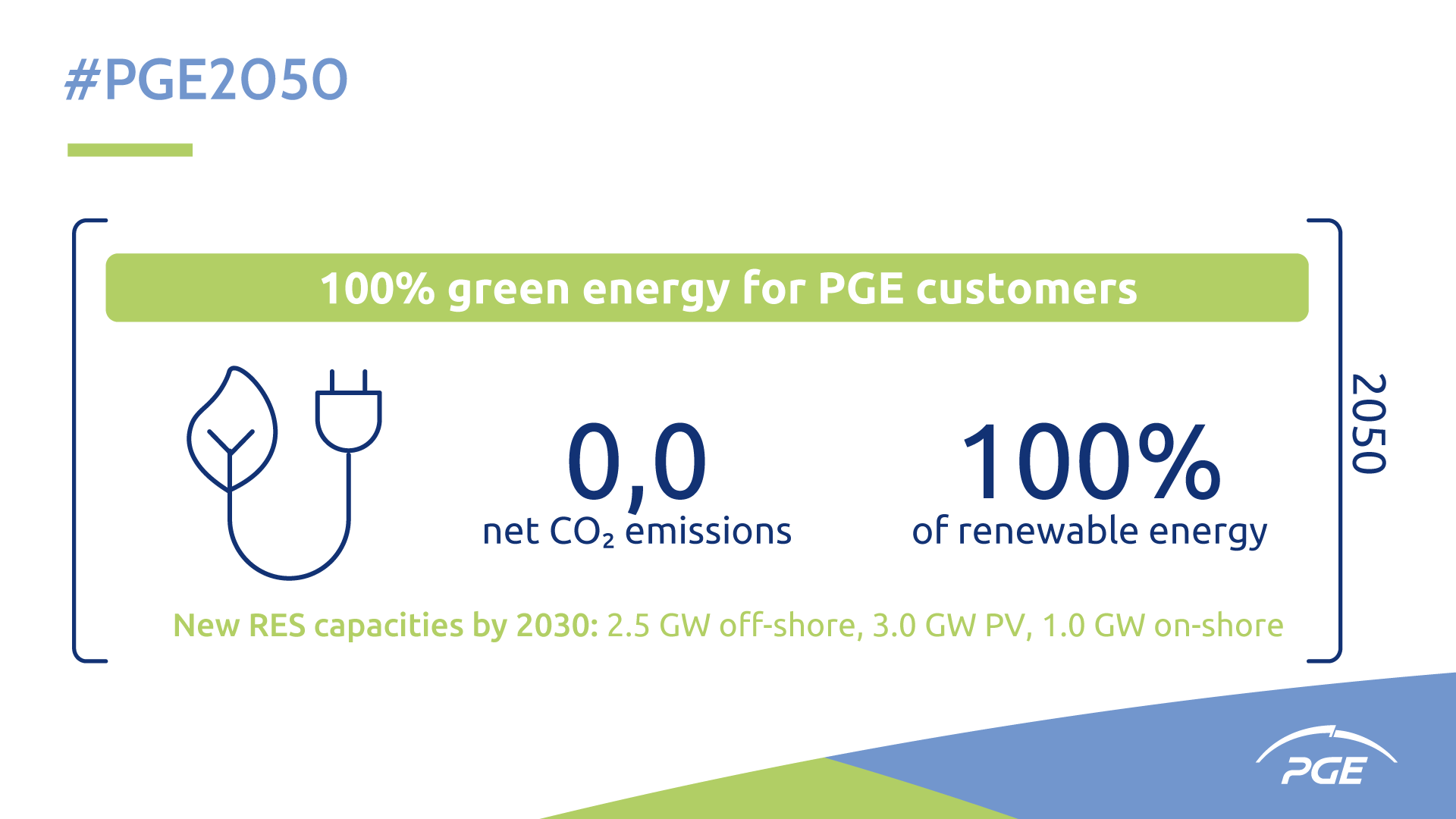What is PGE doing to help Europe meet its climate objectives?
PGE is one of the first Polish companies to declare achieving climate neutrality by 2050 as a key objective. Adopting a new green strategy was an important milestone on our pathway towards a decarbonised future, and we will now do everything we can to live up to our promise. By 2030, we intend to develop 2.5 GW of new capacity in offshore wind farms in cooperation with Danish company Ørsted, 3 GW in photovoltaics, and expand the portfolio of onshore wind farms by at least 1 GW. By 2050, PGE will provide its customers with 100% green energy. We will also pay special attention to district heating, due to its specificity in Poland, it is the hardest segment of the energy market to decarbonise. We plan to contribute to its decarbonisation through further development of district heating, low-emission cogeneration, and zero-emission sources, along with renewable power-to-heat solutions.
Where is the biggest renewables potential in Poland?
The biggest renewable potential in Poland lies in the Baltic Sea, where we have ambitious plans. By 2040, PGE Group intends to build 6.5 GW of new capacity in offshore wind farms. Currently, there are preparations for the construction of three wind farms in the Polish part of the Baltic Sea. Their total maximum capacity will be up to 3.5 GW. Namely, Baltica-1 Wind Farm, with the expected capacity of up to 900 MW, and the Baltica-2 and Baltica-3 Wind Farms with a total capacity of up to 2.5 GW.
The biggest renewable potential in Poland lies in the Baltic Sea, where we have ambitious plans. By 2040, PGE Group intends to build 6.5 GW of new capacity in offshore wind farms
These are very ambitious plans. That is why in the last four months PGE submitted applications for eight location permits for the construction of offshore Paweł Cioch, Vice-President for Corporate Affairs at PGE Polska Group, speaks to the Parliament Magazine about their commitment to tackling climate change but also the challenges ahead wind farms in the Baltic Sea. Offshore wind development is a large-scale infrastructure venture and, as the biggest electricity utility in Poland, we are well placed to implement such an ambitious green investment plan.

How will the Fit For 55 package influence the cost and profitability of new investments for PGE?
The electrification of ‘hard to decarbonise’ sectors cannot be implemented with today’s skyrocketing energy prices. The solutions put forward by the Commission will only increase this trend further, without any effective mechanisms to limit volatility on the carbon market nor prevent excessive price surges. At the same time, we are missing an in-depth cost-benefit analysis of different measures proposed by the Commission at the Member State level. This is well show-cased in district heating, which is very difficult to fully decarbonise. In Poland, there is over 20000 km of district heating networks serving approximately 16 million people. Most of these networks require refurbishment, so changing the energy source to low-temperature renewables is not an option yet. However, we need to move away from coal fast. Therefore, as a transitional solution, we plan to switch to low[1]emission gas. But, with new definitions of efficient cogeneration and district heating proposed in the recast of the Energy Efficiency Directive, it is going to be extremely difficult to do it with public support. That’s why the speed of decarbonisation of the district heating sector should be adjusted to technically feasible solutions. Proposed solutions – including the recently published revision of the Energy Performance of Buildings Directive – do not fully consider the role of natural gas as a transitory solution, which could be used until renewable gases are available.
How will the EU’s emissions trading scheme influence our investment potential?
Solutions proposed in the legislative proposal for the EU ETS revision, namely: an increased Linear Reduction Factor with a one-off cap rebasing to be adopted in 2024, the new Market Stability Reserve design parameters as well as the unlimited participation on the carbon market entities, that have no obligation to surrender allowances against their emissions, will just increase the CO2 price further. It does not mean that we can implement our investment plans faster, as some of the investments need to be carried out in agreement with the Trans[1]mission Operator. With high CO2 prices, the risk occurs that instead of spending the funds on Capital Expenditure (CAPEX) we must use them on Operating Expenses.
When talking about a just transition, we often think about alleviating social effects but forget about investments that create sustainable jobs
With the current carbon prices, PGE alone needs to spend €5 billion per year to cover its annual emissions. The most with Danish company Ørsted, 3 GW in photovoltaics, and expand the portfolio of onshore wind farms by at least 1 GW. By 2050, PGE will provide its customers with 100% green energy. We will also pay special attention to district heating, due to its specificity in Poland, it is the hardest segment of the energy market to decarbonise. We plan to contribute to its decarbonisation through further development of important investments for reducing our emissions will be implemented in 2026. This is why we are looking for external funds to cover our CAPEX needs – only recently PGE Group proposed to issue new shares to implement new investments in renewable energy sources, distribution grids and low-emission generation sources.
What can we do to make the transition more just?
When talking about a just transition, we often think about alleviating social effects but forget about investments that create sustainable jobs that provide a viable alternative for the local workforce. Creating quality jobs through large infrastructure investments from existing EU financing mechanisms, like the Modernisation Fund, should be a top priority. Higher EU funding must be adequately tailored for the needs of CEE countries, which have different investment priorities. We believe that due to enormous investment needs stemming from the EU 2030 target, the Modernisation Fund needs to be substantially increased to enable a just transition of the CEE region. This way the EU can help its low-income Member States to avoid transferring some of the costs of their decarbonisation onto customers. A just transition is not only a matter of funds, a lot of which are already on the table, but also their availability for investors and giving them adequate time for transformation.

This content was commissioned by PGE Polska Group and produced by Dods
Sign up to The Parliament's weekly newsletter
Every Friday our editorial team goes behind the headlines to offer insight and analysis on the key stories driving the EU agenda. Subscribe for free here.